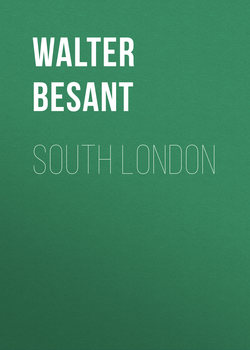South London

Реклама. ООО «ЛитРес», ИНН: 7719571260.
Оглавление
Walter Besant. South London
PREFACE
CHAPTER I. THE FIRST SETTLEMENTS
CHAPTER II. EARLY HISTORY
CHAPTER III. A FORGOTTEN MONASTERY
CHAPTER IV. THE ROYAL HOUSES OF SOUTH LONDON
CHAPTER V. PAGEANTS AND RIDINGS
CHAPTER VI. A FORGOTTEN WORTHY
CHAPTER VII. THE BOMBARDMENT OF LONDON
CHAPTER VIII. THE PILGRIMS
CHAPTER IX. THE LADY FAIR
CHAPTER X. ST. MARY OVERIES
CHAPTER XI. THE SHOW FOLK
CHAPTER XII. BELOW BRIDGE
CHAPTER XIII. THE LATER SANCTUARY
CHAPTER XIV. IN THE EIGHTEENTH CENTURY
CHAPTER XV. THE DEBTORS' PRISON
CHAPTER XVI. THE PLEASURE GARDENS
CHAPTER XVII. SOUTH LONDON OF TO-DAY
Отрывок из книги
I propose to call the series of chapters which are to follow by the general name of 'South London.' Like their predecessors on 'London' and 'Westminster,' they will not attempt, or pretend, to present a continuous history of this region – or, indeed, a history at all: they will endeavour to do for this part of London what their predecessors have already attempted for the Cities of London and Westminster: that is to say, they will present such episodes and incidents, with such characters, as may serve to illustrate the life of the place; the manners and customs of the people; the characteristics of the Borough and its outlying suburbs. So far as history means the march of armies and the clash of armour, we shall here find little history. So far, also, as history means the growth of our liberties, the struggles by which they were won; the apparent decay, or defeat, from time to time, of the spirit of freedom, with its inevitable recovery: the reader and the student may be referred to the pages of a Stubbs or a Freeman – not to my humbler page. Great is the work, and worthy to be held in the highest honour, of those who trace out the irresistible march of national freedom: I cannot join their company; I must be contented with the lowlier, yet somewhat useful, task of showing how the people, my forefathers, lived, and what they thought, and how they sang and feasted and made love and grew old and died.
My South London extends from Battersea in the west to Greenwich in the east, and from the river on the north to the first rising ground on the south. This rising ground, a gentle ascent, the beginning of the Surrey hills, can still be observed on the high roads of the south – Clapham, Brixton, Camberwell. It now occupies the place of what was formerly a low cliff, from ten to thirty or forty feet high, overhanging the broad level, and corresponding to those cliffs on the other side of the river, which closed in on either side of Walbrook and made the foundation of London possible. If we draw a straight line from the mouth of the Wandle on the west to the mouth of the Ravensbourne on the east, we shall, roughly speaking, indicate the southern boundary of our district; unless, as we may very well do, we include Greenwich as well. The whole of this region constitutes the Great South Marsh: there is no rising ground, or hillock, or encroaching cliff over the whole of this flat expanse. Before the river was embanked it was one unbroken marsh: for eight miles in length by a varying breadth of about two or two and a half miles, the tidal stream twice in the twenty-four hours submerged this space. Here and there lay islets or eyots, created, as the centuries crept on, by the gradual accumulation of branches, roots, reeds and rubbish, till they rose a few inches above high water; the spring-tide covered them – sometimes swept them away – then others began to form. In later times, after the work of embankment had been commenced, these islets became permanent, and were afterwards known as Battersea, Bermondsey, Rotherhithe, Lambhithe, Newington, Kennington. Even then, for many a long year, they were but little areas rising a foot or two above the level, covered with sedge, reeds, and tufts of coarse grass, hardly distinguishable from the rest of the ground around them. Before the construction of the river wall, no trees stood upon this morass, no flowers of the field flourished there, no thorns and bushes grew, no cattle pastured there; the wild deer were afraid of it: there were no creatures of the land upon it. On the south side rose the cliff of clay and sand, continually falling and continually receding before the encroaching tide; on the north side ran the river; beyond the river the cliff stood up above the water's edge, where the tiny stream, afterwards named from the Wall, leaped bright and sparkling into the rolling flood. No man could live upon that marsh: its breath after sunset and in the night was pestilential.
.....
These were the conditions. We should expect, therefore, to find the place thinly inhabited; and to find that the houses were all built beside or along the raised ways. We should next expect to find along the causeways that the houses belonged to the wealthier class.
We should expect, further, to find no sailors' or working men's quarters. The former because there were no ships; the latter because there were no markets. Lastly, we should not be surprised to find the place very early occupied by inns and places of accommodation for those who resorted to London.
.....